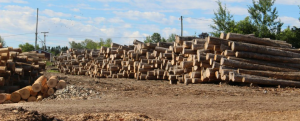Carbon Pricing-Is Anyone Listening?
 Carbon Pricing – Is anyone listening?
Carbon Pricing – Is anyone listening?
Since I presented to the Select Committee on climate Change in September of 2016, Forest NB and the industry it represents has and continues to demonstrate support for action to be taken to address the effects of climate change and mitigate further impacts of global warming upon our province, it’s forest resources and the communities that depend upon it.
Low hanging fruit
Back in 2016 our focus was on suggesting to the committee ways to build resiliency and mitigate change. The pulp and paper sector, nationally, had already reduced its total emissions of GHG by 60% since 1990. Further emission reductions would be very difficult to achieve and, if at all possible, very expensive. The low hanging fruit of co-generation with biomass for combined heat and power, investment in recovery boilers and switching from bunker oil to alternate fuel sources had pretty much been realized by the year 2010 to the credit of industry investment and partly the federal Pulp and Paper Green Transformation Program. Already top quartile performers globally, we figured if our industry was going to emit any CO2, and the reality is that we will, then our focus should be on how we could mitigate the effects?
Silviculture and Sequestration
In my presentation to the select committee I pitched for further investment in intensive silviculture on both crown and private land. We were not alone in this. In fact, a coalition of groups representing private woodlot owners across Canada including the New Brunswick Federation of Woodlot Owners, saw value in a similar strategy and went as far as to prepare a formal proposal in July of 2016 seeking federal support for this type of mitigation action. As with Forest NB’s suggestion to the provincial select committee, the private woodlot proposal seemed to get no traction in Ottawa. The reasons for inaction on this were perhaps made clear in early 2017 when Environment and Climate Change Canada (ECCC) issued their Technical Paper on the Federal Carbon Pricing Backstop. The focus from the feds was clearly on emission reduction with mitigation being secondary. This technical paper laid out the framework for how Ottawa would deal with provinces unwilling to design and implement carbon pricing systems of their own that would meet the equivalent outcomes outlined in the Pan Canadian Approach to Pricing Carbon Pollution issued in 2016. Basically, show incremental reductions in emissions over time and have an acceptable degree of stringency which means make everyone feel a bit of the pricing pain to drive changes in behaviour. To a degree this made sense until you see how the pricing pain was to be distributed. Unintentional as it was, New Brunswick was being dealt a bad hand.
Push for a Made in NB System
The crux of the problem was and remains that the federal system was not designed to consider all the regional nuances that go with applying a broad policy such as the Carbon Pollution Pricing Approach. In fairness to the feds they were probably as shocked as industry that any province would willingly adopt the backstop as a reasonable alternative to a provincially crafted plan. In fact, we were, for a short time, the only game in town for ECCC to impose their one size fits all Federal Backstop Pricing Plan. By the end of September 2018 all provinces, except NB, had some variation of a complete or partial carbon pricing plan. A change in government in late September renewed the argument for pitching a New Brunswick made pricing plan but shifting provincial election outcomes, court challenges and a federal election call put the province and Ottawa at odds with one another.
The current offer
Forest NB and its industry cohorts consulted extensively with the provinces Climate Change Secretariat and lobbied rigorously with federal representatives and New Brunswick MP’s to give due consideration to a New Brunswick solution. It is our understanding that a plan was drafted and presented to ECCC based somewhat on the federally accepted Saskatchewan model. The Saskatchewan model did not adopt a fuel levy and thus defaulted to the federal fuel levy schedule, mainly for motive and heating fuels, but did outline an out-put based pricing system, similar in nature to the federal backstop, with emissions measured against a benchmark and reduction targets that demonstrate graduated stringency in emission intensity over time.
Now we wait for a signal from Ottawa that the made in NB proposal passes muster. Unfortunately, our fears of a solution getting caught up in political machinations are becoming a reality. Governments both federal and provincial may believe they will distinguish themselves by drawing a line in the sand on this issue but they should be wary of the wave of public contempt that will wash over them all if our industries can’t get on with the job of keeping our businesses running competitively in New Brunswick.
Author: Mike Légère, Executive director of Forest NB
